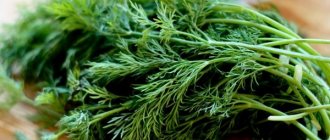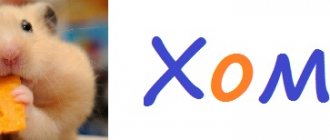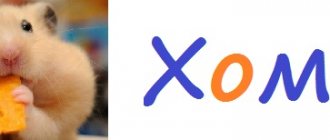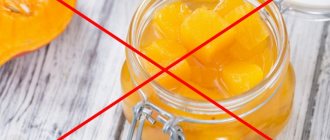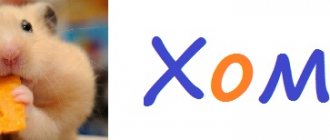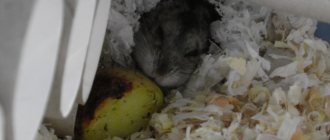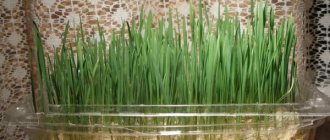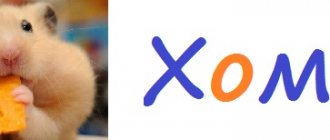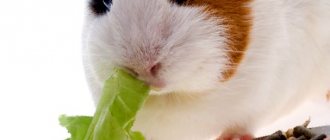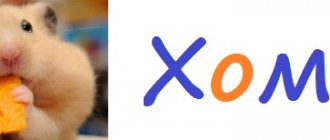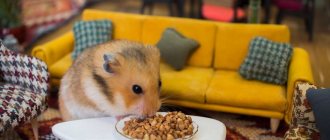- home
- Nutrition
23.03.2018
Hamsters are common rodents and in nature they eat whatever they can find. If in nature an animal finds food on its own, then in captivity it is completely dependent on the owner. Therefore, owners often have a question: what to feed their pet, whether hamsters can eat peas, beans and corn. Let's figure it out in order.
The animal's main diet is a grain mixture of cereals, legumes, nuts, vitamin supplements and other products. You can buy this food at a pet store. Feeds vary in composition and quality. Sometimes an animal refuses to eat food from a certain brand, then you need to change it.
Peas in a hamster's diet
Often, hamster owners do not include peas in their diet, complaining of its negative effects on the digestive system. However, the product is important for diversifying a hamster’s diet, containing many beneficial microelements.
You can give your hamster peas in different ways:
- Boiled. It is recommended to cook peas for elderly pets, or if they have illnesses. It does not take long to cook; 15 minutes of cooking after boiling water is enough to bring it to a soft state. Otherwise, when it is cooked for a long time, vitamins are lost.
- Dry. An alternative to buckwheat, dry peas are also included in the diet, but be careful with young individuals - this can be dangerous for their teeth.
- Fresh. Fresh peas have much more vitamins than dried peas. In addition, your hamster can eat it with the pod, which will supplement the diet with vitamins.
- Soaked. To improve your hamster's digestive system, you can give him soaked peas. You should fill it with warm water for several hours.
The only limitation is that canned peas cannot be given to hamsters, due to the preservatives and spices present in the brine.
Carefully introduce chickpeas into your diet, which contain a large number of trace elements, including phytic acid, which binds calcium, iron, zinc and other trace elements, preventing them from being absorbed, which leads to the risk of osteoporosis and rickets. To prevent the formation of diseases, legumes should be soaked overnight.
Authorized Products
Syrian hamsters are not picky eaters; they can even be fed homemade food. In order for a small animal to feel good and always be in a great mood, it needs the following products:
- grain mixtures;
- vegetables;
- fruits and berries;
- grass and greenery;
- tree branches;
- vitamins;
- water.
When compiling a diet, you need to take into account that the menu should be varied so that the hamster receives the maximum amount of vitamins contained in the products.
Hard food
The basis of the diet for rodents is a grain mixture. It is mainly grain crops that hamsters eat in the wild. The fruits of cereals, seeds of legumes and other plants can be bought at any pet store.
Special mixtures must contain:
- wheat;
- corn;
- oats;
- sunflower seeds;
- red millet;
- split peas;
- sesame;
- peanut.
It is recommended to feed the Syrian hamster 2 times a day, in the morning and evening, giving approximately 1 tbsp at a time. l. grain mixture.
It is important to be attentive to your pet. Often the rodent eats the most delicious grains from the feeder, and scatters the rest, which contain a whole range of useful substances, throughout the cage. For example, if a hamster chooses only seeds and nuts from its food, then it will quickly gain excess weight. Therefore, you need to ensure that the percentage of seeds and nuts containing a significant amount of fat is minimal.
It is also recommended to include pumpkin, watermelon and melon seeds in the rodent's menu, after washing and drying them, and only in limited quantities. These foods are high in fat and very high in calories.
Vegetables
The Syrian hamster's daily diet should include juicy vegetables rich in vitamins and minerals. The most useful vegetable crops for rodents:
- carrot;
- zucchini;
- cucumber;
- Bell pepper;
- beet;
- radish;
- pumpkin.
It is preferable to give your hamster vegetables grown on your own property. They do not contain chemical compounds that are dangerous to the hamster's body. Even a small dose of harmful substances, penetrating into the pet’s esophagus, can provoke reflux.
Prohibited vegetables include white cabbage; it is dangerous to give to a hamster; in large quantities it can be fatal. You also need to exclude garlic, onions, and potatoes from the menu.
Grass and greenery
It is recommended to supplement the Syrian hamster's diet with herbs. Among the useful plants:
- knotweed;
- dandelion leaves;
- plantain;
- alfalfa;
- clover;
- burdock;
- whine.
Grass for feeding your pet is collected away from busy highways, factories, boiler houses, and power plants. Before feeding it to the hamster, the grass is thoroughly washed with running water and dried.
Wild hamsters in nature regularly replenish their diet not only with fresh, but also with dry grass. Hay improves digestion and allows you to grind down your incisors. Rodents' teeth grow constantly, and if they are not ground down, then at home the hamster will lose the opportunity to eat properly and will have to contact a veterinarian for help.
Fruits and berries
In the summer, there is an abundance of fruits and berries; you can pamper your pet with juicy and healthy fruits.
List of permitted fruits and berries:
- Pears, apples . The fruits are rich in vitamins C, E, and contain calcium, phosphorus, magnesium, and iron. These valuable substances support the hamster’s immunity, strengthen bones and teeth.
- Apricot, plum . Fruits contain vitamins B, C, trace elements, and carotenoids. It is recommended to give the rodent slightly unripe fruits. It is not recommended to feed overripe fruits.
- Banana is allowed to be given to your hamster daily. Fresh fruit contains a small amount of sugar and is very beneficial for the health of the rodent.
- Grape . The valuable components contained in the berries have a positive effect on the functioning of the heart and blood vessels. But it is not recommended to get carried away with grapes: you can give them 3 pieces per week. In addition, the berries should be given without seeds. In order not to peel them manually, it is better to choose sultanas or another seedless variety.
- Raspberries are recommended to be included in a hamster’s diet to prevent vitamin deficiency and generally strengthen the immune system. You should not feed your pet raspberries too often, so as not to provoke an upset stomach.
- Strawberry, strawberry . Syrian hamsters especially love these berries, but first you need to give the animal a small piece to make sure there is no allergic reaction or digestive problems.
- Cherries, cherries - can be given in limited quantities, no more than 2 pieces per 1 feeding.
Before treating your Syrian hamster to fruits and berries, you should first remove the seeds and seeds and cut the pulp into small pieces.
Prohibited berries and fruits include kiwi, avocado, carom, passion fruit, gooseberries, sea buckthorn and lingonberries, as well as citrus fruits.
Water
In addition to absorbing moisture from natural products, the hamster needs to be given filtered or bottled water. The liquid should be changed once a day, and the drinking bowl should be thoroughly washed.
Beans
Legumes are often a staple in a hamster's diet, including beans. It can be given in any form, including dry, fresh and thawed. However, it has the best effect on your pet’s health when consumed fresh, as it contains more nutrients.
IMPORTANT! Not all beans are good for your hamster. Red beans (kidni) can only harm him, since their toxicity will lead to deterioration of the animal’s digestion, which is why it should not be consumed.
Green beans are also suitable for consumption. It is most often found frozen, but pets prefer it fresh because of the juice it contains. Before serving defrosted green beans, check its composition; it should not contain any preservatives, which are often added to improve the taste of the product, and additives are dangerous for rodents.
Before giving it to the hamster, it is better to soak the beans, because this way they are better absorbed, giving useful microelements to the rodent’s body. For soaking, one night and water at room temperature is enough.
What else can you give?
The diet of a Syrian hamster should be complete, balanced and varied, therefore it is recommended to additionally include the following products in the menu:
- Protein feeding . Several times a week the rodent is given protein food: cottage cheese, meat, fish, eggs, kefir. Products must be fresh. The meat should be well boiled in advance without salt or spices. It is recommended to give your pet protein food 2-3 times a week, alternating foods.
- Crackers . When processed, the yeast found in baked goods is deprived of qualities harmful to the health of the hamster. At the same time, dried bread is suitable so that the animal can grind its constantly growing teeth on it. The main condition is independent production of crackers. Store-bought products contain food additives and flavor enhancers that can harm the animal. Both white and black bread are used to make crackers, but it is better to choose baked goods with bran or grain additives.
- Mineral supplements (chalk, charcoal, calcium in the form of calcium gluconate and glycerophosphate tablets).
- Dried fruits (raisins, dried apricots, prunes) can be given to Syrian hamsters no more than 2-3 times a week; they contain a large amount of sugar. First you need to boil the dried fruits for about 10 minutes.
A well-prepared diet for a rodent plays a huge role in its life, including significantly prolonging the pet’s life.
Corn
To diversify your hamster's diet, you can give him corn. But keep in mind that it cannot be used as preserved food. It is dangerous for hamsters to eat canned corn due to the preservatives contained in the product. Artificial additives and flavors become poison for their body.
ATTENTION! It is better not to give corn to Djungarian hamsters, this is due to their predisposition to obesity and high sugar content.
You can feed your hamster corn in any other form:
- Dry. Dry grains are good for hamsters to eat, but they are reluctant to eat them due to the lack of special taste.
- Fresh. Grains are very useful for a hamster, as they contain 26 elements of the periodic table, which makes it possible to treat many diseases of the animal. They're great for variety, but don't feed them too much as fresh corn contains a lot of natural sugar, which can be harmful to your pet. The cobs and leaves are also suitable for consumption; they contain many vitamins that are beneficial for pets of any age.
- Boiled. Despite the fact that after heat treatment some of the vitamins are lost, it is also possible to give grains to hamsters in this form. To do this, you need to cook them for up to 20 minutes, otherwise they become tough, less tasty and healthy.
- Soaked. It is preferable to feed soaked grains, this way all the beneficial substances and microelements in the product are preserved. In addition, hamsters will eat soaked corn much more readily than dry corn.
- Corn porridge. You can give it to hamsters every day, regardless of age and health status. You need to cook the porridge in water, without adding spices or oil.
Corn is healthy, which is why it is often recommended by veterinarians to treat diseases associated with digestive problems. You can take it as a preventive measure for cancer; for this you need to cook porridge, or mix different types of grains.
Corn sticks, cereal and popcorn
Corn is good for hamsters, but you should be careful with the products made from it, as they are harmful due to the high content of additives.
Because hamsters should not be given any spices, corn sticks and flakes should not be given to rodents. A high content of artificial sugar can lead to the development of diabetes in a rodent, which often results in complications and early death.
Popcorn is included in some foods and can also be prepared at home without the use of additives. However, the store-bought product is dangerous for hamsters due to the content of salt, sugar, preservatives and oil.
Why shouldn't hamsters be given popcorn?
When manufactured in production, fats, sugars, and salt are added to the corn-based product to make the airy delicacy more attractive to the buyer. This is also what makes popcorn harmful to your pet. Djungarian hamsters can develop diabetes from such “goodies.”
If you want, you can pamper the animal with homemade puffed corn without additives. Sometimes it is present in this form in prepared animal feeds. This is convenient because... The contents of the pack are already ready to eat.
Rest assured, the manufacturer has thought through the quantity, nutritional value and safety for you. You just need to look at the daily value on the packaging and feel free to offer the treat to the animal.
What can and cannot be fed to hamsters?
Grain mixture.
The feed should be in the form of granules or a mixture of seeds. Most often these are cereals (oats, wheat), millet, corn, seeds (pumpkin, watermelon, sometimes sunflower), peas, beans. Sometimes you can give nuts: cashews, pine nuts, peanuts, walnuts. The food may also include dried berries and pieces of fruit - an additional treat for rodents. The feeder should not always be empty, because then the hamster will think that food is running out and will begin to make strategic reserves. In winter and autumn, hamsters can be given whole grain bread; in summer, their consumption is reduced.
Green food.
All greenery should be collected away from roads, if possible outside the city. You can give dandelion leaves, plantain leaves, clover leaves, meadow grasses, lettuce, beet and carrot tops. Sprouted grains (oats and wheat) are also beneficial for hamsters. In winter, rodents should not lack hay. To grind down the incisors, give tree branches (pre-washed and scalded with boiling water) - apple tree, linden, maple, birch, willow, raspberry, black currant, rose hip, pear and others.
Vegetables and fruits.
You can and should add pieces of vegetables and fruits to your rodent’s diet. This could be carrots, zucchini, beets, tomatoes, cucumbers, potatoes, pumpkin, bell peppers. As for fruits, these are pieces of apples, peaches, apricots, bananas, pears; in winter, you can give soaked unsweetened dried fruits. Berries - strawberries, currants, wild strawberries, raspberries, blueberries, cherries.
Animal products.
You can also include a small amount of cottage cheese, milk, boiled eggs in the diet, and pieces of boiled meat once a week. Many hamsters also eat small insects: beetles, grasshoppers, locusts, ants, worms. It is better to purchase “live” food at a pet store.
ONTO Biotechnology company launched the production of canned crickets. This is a unique product that contains only whole, fresh crickets, which do not contain any preservatives, chemicals, or medications. Insects are grown on our own eco-farm, under the strict supervision of specialists. Therefore, cricket is very useful for rodents.
The house cricket (Acheta domesticus) is a dietary, healthy product containing a lot of protein, calcium, chitin, 9 amino acids, OMEGA-3 and OMEGA-9 polyunsaturated fatty acids, vitamin B12, oligosaccharides. These insects contain little fat, so the animals will not gain excess weight.
Vitamins and mineral supplements
. They can be purchased at pet stores, most often they are sold in the form of tablets or liquid drops - they can be added to fresh food. There should also be mineral stones in the cage - they are used not only for the hamster to sharpen its teeth, it is also a powerful source of calcium, phosphorus and other trace elements. We would like to remind you that there is no need to be overzealous with vitamins: follow the dosage indicated by the manufacturer, or even better, consult a veterinarian.
It is recommended to feed fresh food in the morning and grain food in the evening. There is less chance that the hamster will hoard a perishable product in reserve. When choosing ready-made food, try to take mixtures that contain a minimum of sunflower seeds: hamsters love this delicacy very much and often choose only this from the bowl, and the rest of the food goes to waste
The packaging must be sealed and indicate the expiration date and composition of the product - pay attention to this.
You should not give your hamster food from your table, exotic fruits, mushrooms, flour, fatty dairy products, sweets, garlic, onions, sorrel, cabbage.
Some of the most common diseases that lead to the death of furry little pets relate to disorders in the gastrointestinal tract. It is precisely violations of the requirements for organizing a complete, balanced diet and timely feeding of hamsters that can seriously reduce their life expectancy. This is the main reason why experienced owners recommend first finding out about caring for a new furry family member, and then making the final decision about purchasing one. However, you should take a serious approach not only to the composition of the diet, but also to maintaining hygiene, as well as the feeding regimen of the animal.
